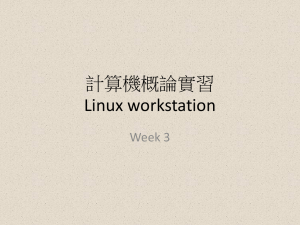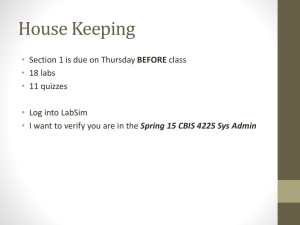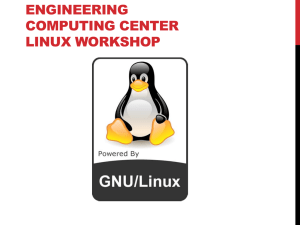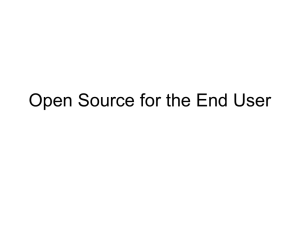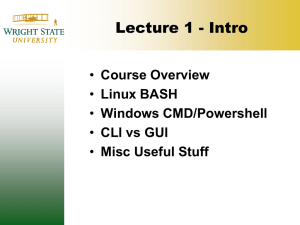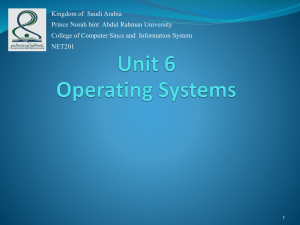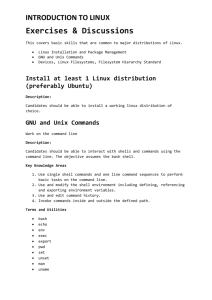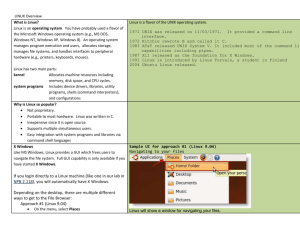Intro and using Linux Commands
advertisement
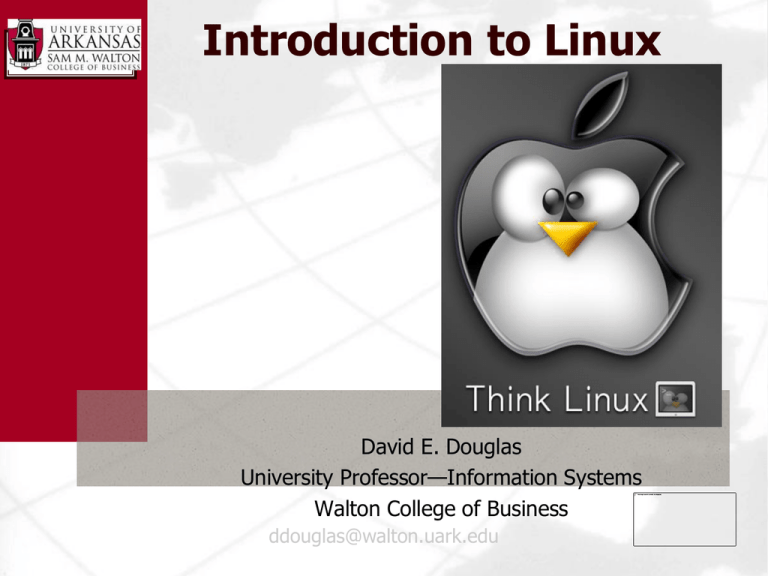
Introduction to Linux David E. Douglas University Professor—Information Systems Walton College of Business ddouglas@walton.uark.edu Reading assignments Mainframe SOA Cloud, SOA, Integration Sanity Check, Take Heart, Tainted Ones Carico—most cost effective platform Ageless Mainframes Support Multiple Antares Missions Insurance, CICS/DB2, mainframe hosting Examining the Usefulness of zIIP and zAAP z Integrated Information Processor z Application Assist Processor Linux and Open Source Linux-Who & When Linus Torvalds, graduate Student; Helsinki, Finland Free Software Foundation- Who, What, When Larry Stallman, 1985, source code free Open Source Initiative-Who, What, When Jon Hall and others, 1998; used Open instead of Free GNU General Public License copyleft—requires derived works to be open Linus Torvalds used this License for Linux Using LINUX: A Beginner’s Guide By David Douglas and Peggy L. Lane The major operating system services provide mechanisms for… Execution of a program, Input and output operations performed by programs, Communication between processes, Error detection and reporting, and Manipulation of all types of files. Features of the Linux OS Multiuser capability Portability Multitasking Ability to use multiple processors Multiple modes of operation Multiuser Capability Linux handles multiple requests by a number of users. Many companies run Linux as their main OS for their business for this reason. Portability Portability means Linux can run on numerous hardware systems. Can run on either CISC or RISC processors: – CISC – Complex instruction set computer – RISC – Reduced instruction set computer (reduced number of instructions because the hardware performs tasks not in the instruction set) Multitasking When an OS handles multiple jobs at seemingly the same time. Linux uses preemptive multitasking – The OS has the ability to take control of the system from an application – Other method is cooperative multitasking – the application takes control of the system resource. – Which one can crash the whole system if the application crashes??? Ability to Use Multiple Processors Linux can accommodate up to 32 processors. Also uses multithreading – Allows for a program to be split across several processors – with each processor working on a different piece of the program at the same time. Multiple Modes of Operation Graphical User Interface (GUI) Text – commands are used to navigate the Linux system and write shell scripts. Access text mode in the Linux OS via a shell (must follow its syntax or rules): – – – – sh: the original shell(Bourne Shell by Steven Bourne) bash: default shell (usually) ba = Bourne again shell csh: C-shell that uses a C-like syntax. ksh: Publicly licensed Korn shell by David Korn. Layered View Users AUI – Application user’s interface – (LINUX shell, commands, and application programs) API – Application Programmer’s Interface – language libraries and system call interface Operating system kernel – core of the OS Computer hardware October, 1991 Posted on a newsgroup: – “I’m doing a (free) operating system (just a hobby, won’t be big and professional like GNU) for 386 (486) clones.” – Linus Torvalds, 21 year old student at the University of Helsinki, Finland A few things to remember LINUX was designed to be a command line user interface. Everything in LINUX is a file. – Even devices (hard drives, floppy drives, etc.) LINUX is case sensitive. – The file name “resume” is NOT the same file name as “Resume” or “RESUME”. – Linux commands are all lower case and environment variables are all upper case LINUX System File Structure Root directory (/) – At the top of the file system hierarchy. – Denoted by / – Can be thought of as the master cabinet that contains all drawers - folders, and files. / bin usr home LINUX System File Structure /bin (binary) – contains executables for every user /boot – contains the kernel image, system map, bootstrap, etc. /dev – contains special files that represent hardware devices /etc – contains configuration files /home – contains users’ home directories LINUX System File Structure /lib – contains libraries /media /mnt – contains mount points for other file systems /opt – used to install add-on software packages /proc – virtual file system (in memory) contains kernel & process info /root – home directory for root user. – Protected from normal users. /sbin – contains system admin executables (super user bin) LINUX System File Structure /srv – Services /subdomain /sys /tmp – temporary storage space /usr – UNIX System Resources - contains all nonessential programs and libraries, which can be either NFS mount or read only. – Contains numerous subdirectories. One of which is bin. /var – contains log & spool files, temp storage space (other than /tmp) The /bin folder /bin Contains general-purpose commands such as: cat – concatenates or displays files chmod – changes security mode of a file or directory date – displays the system date. echo – displays a message kill – ends a process mail – read mail or send mail to users more – browse or page through a text file one page at a time (use spacebar to advance by page) ps – shows processes on a system /bin mkdir – create one or more directories under a parent directory. cp – copies files from one directory to another mv – moves files from one directory to another pwd – displays your current path ls – List contents of a directory. – -l option lists file in long format – -r option lists in reverse alphabetical order. rm – removes a file – -r option deletes a specified directory and its contents. rmdir – removes a directory (must be empty) What is my “default” directory? /home/userid All of your files should be placed in or under this directory. Looks like this: userid@elinux:~> To get to your “home” no matter where you are, type: – cd ~ (and press the enter key) – be sure to leave a space between cd and ~! A detailed Command Reference Guide http://www.perpetualpc.net/srtd_commands_rev.html Other Commands cal – displays calendar passwd – allows you to change your password. cd .. – goes “up” a level in the structure cd / - goes to the root directory (if access is granted) echo $HOME – displays your home directory tree – lists the structure (folders and files) Editors There are many editors for the Linux environment—some are listed below – vi (visual editor) is the most popular editor – emacs – pico – joe – jpico; the simple editor used for this class Tree Command pllane@elinux:~> tree . |-- china | |-- clothing | | |-- clothing | | `-- clothinginIndia | |-- food | | `-- foodinIndia | `-- sports | `-- sportsinChina `-- india |-- food | `-- foodinIndia `-- sports 7 directories, 5 files pllane@elinux:~>

